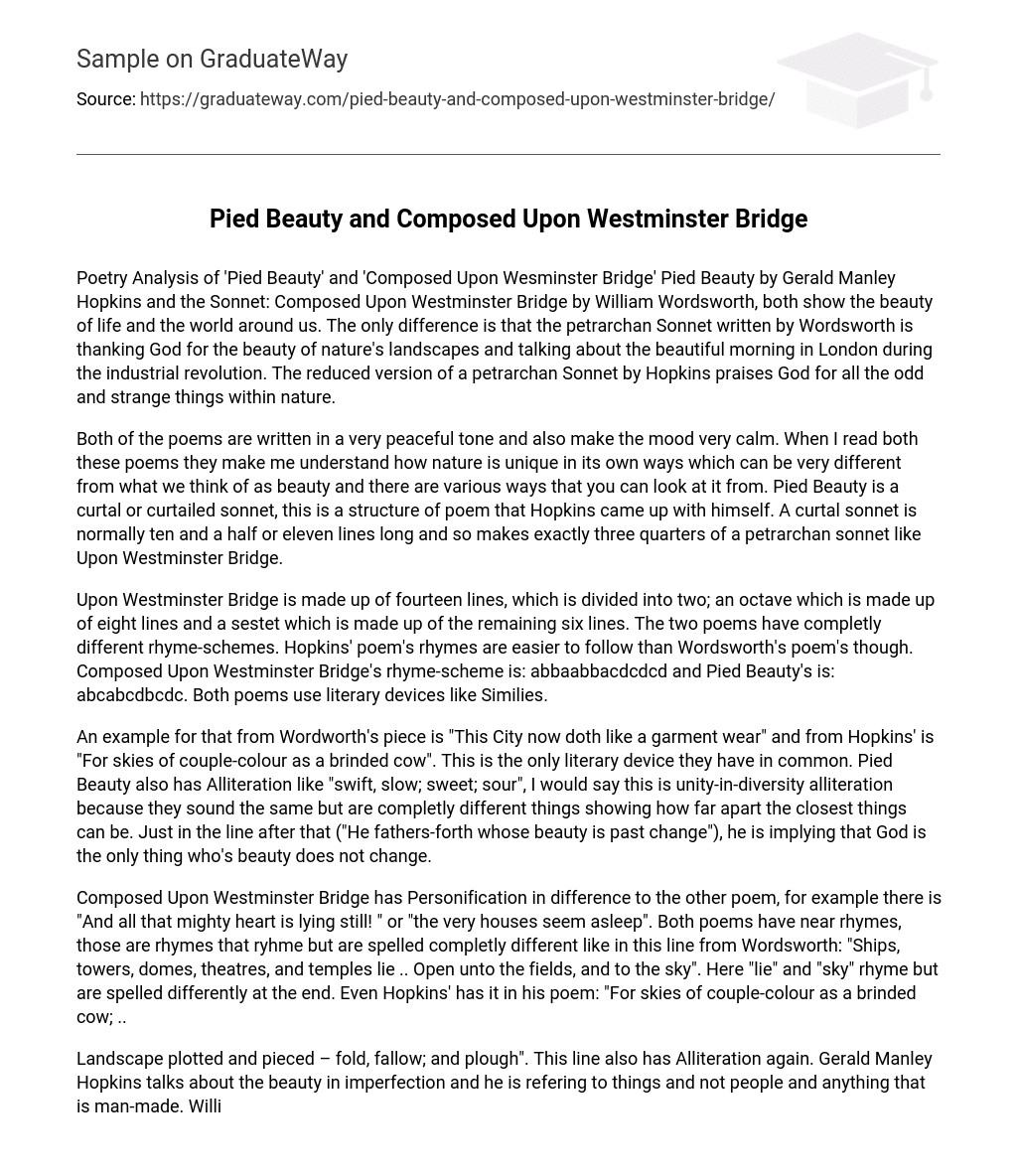Poetry Analysis of ‘Pied Beauty’ and ‘Composed Upon Wesminster Bridge’ Pied Beauty by Gerald Manley Hopkins and the Sonnet: Composed Upon Westminster Bridge by William Wordsworth, both show the beauty of life and the world around us. The only difference is that the petrarchan Sonnet written by Wordsworth is thanking God for the beauty of nature’s landscapes and talking about the beautiful morning in London during the industrial revolution. The reduced version of a petrarchan Sonnet by Hopkins praises God for all the odd and strange things within nature.
Both of the poems are written in a very peaceful tone and also make the mood very calm. When I read both these poems they make me understand how nature is unique in its own ways which can be very different from what we think of as beauty and there are various ways that you can look at it from. Pied Beauty is a curtal or curtailed sonnet, this is a structure of poem that Hopkins came up with himself. A curtal sonnet is normally ten and a half or eleven lines long and so makes exactly three quarters of a petrarchan sonnet like Upon Westminster Bridge.
Upon Westminster Bridge is made up of fourteen lines, which is divided into two; an octave which is made up of eight lines and a sestet which is made up of the remaining six lines. The two poems have completly different rhyme-schemes. Hopkins’ poem’s rhymes are easier to follow than Wordsworth’s poem’s though. Composed Upon Westminster Bridge’s rhyme-scheme is: abbaabbacdcdcd and Pied Beauty’s is: abcabcdbcdc. Both poems use literary devices like Similies.
An example for that from Wordworth’s piece is “This City now doth like a garment wear” and from Hopkins’ is “For skies of couple-colour as a brinded cow”. This is the only literary device they have in common. Pied Beauty also has Alliteration like “swift, slow; sweet; sour”, I would say this is unity-in-diversity alliteration because they sound the same but are completly different things showing how far apart the closest things can be. Just in the line after that (“He fathers-forth whose beauty is past change”), he is implying that God is the only thing who’s beauty does not change.
Composed Upon Westminster Bridge has Personification in difference to the other poem, for example there is “And all that mighty heart is lying still! ” or “the very houses seem asleep”. Both poems have near rhymes, those are rhymes that ryhme but are spelled completly different like in this line from Wordsworth: “Ships, towers, domes, theatres, and temples lie .. Open unto the fields, and to the sky”. Here “lie” and “sky” rhyme but are spelled differently at the end. Even Hopkins’ has it in his poem: “For skies of couple-colour as a brinded cow; ..
Landscape plotted and pieced – fold, fallow; and plough”. This line also has Alliteration again. Gerald Manley Hopkins talks about the beauty in imperfection and he is refering to things and not people and anything that is man-made. William Wordsworth is talking about the beauty of London when he was there with his sister. They visited London and looked at the Westmister Bridge an early morning during the industrial revolution. That is what inspired him to write this poem and he put into the title “Composed Upon Westminster Bridge”.
He even compares the city to the beauty of the countryside like he is talking about “The river glideth at his own sweet will”. I think these poems might seem similar but when they are clearky analysed they do not actually talk about the same things anymore. The analysis shows that Composed Upon Westminster Bridge by William Wordsworth is also worshiping everything in the place he describes including man-made things and that is exactly what Hopkins does not do in his poem. He just talk about nature and the special things in life which we need to thank God for.
Olivia Gunther Words: 652 Pied Beauty by Gerald Manley Hopkins: Glory be to God for dappled things – | | For skies of couple-colour as a brinded cow; | | For rose-moles all in stipple upon trout that swim; | | Fresh-firecoal chestnut-falls; finches’ wings; | | Landscape plotted and pieced – fold, fallow, and plough; | | And all trades, their gear and tackle and trim. | | All things counter, original, spare, strange; | | Whatever is fickle, freckled (who knows how? ) | |
With swift, slow; sweet, sour; adazzle, dim; | | He fathers-forth whose beauty is past change: | | Praise him. Sonnet: Composed Upon Westminster Bridge by William Wordsworth: | | Earth has not anything to show more fair:Dull would he be of soul who could pass byA sight so touching in its majesty:This City now doth like a garment wearThe beauty of the morning; silent , bare,Ships, towers, domes, theatres, and temples lieOpen unto the fields, and to the sky,All bright and glittering in the smokeless air.
Never did the sun more beautifully steepIn his first splendour, valley, rock, or hill;Ne’er saw I, never felt a calm so deep! The river glideth at his own sweet will:Dear God! the very houses seem asleep;And all that mighty heart is lying still!





